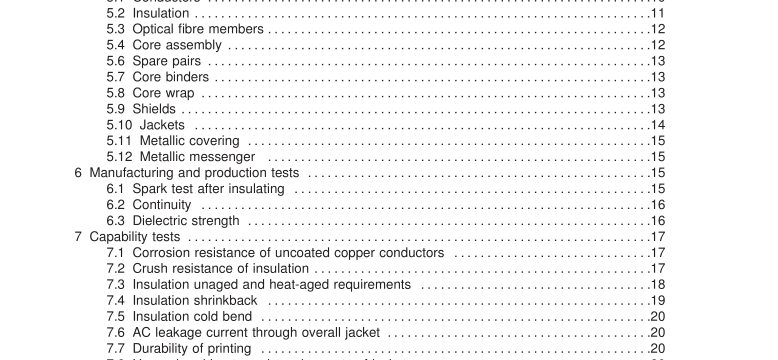UL 444-2010 pdf download.Communications Cables.
1 Scope 1 .1 This standard applies to 60 – 250°C single- or multiple-conductor jacketed or unjacketed, integral or nonintegral cables and single or multiple coaxial cables for telephone and other communication circuits such as voice, data, and audio for on-premise customer systems. These cables are not prohibited from containing one or more optical fibre members. For the purpose of this standard, a coaxial cable or coaxial member conductor is a single conductor with a shield. For the purpose of this standard, a single- or multiple-conductor unjacketed cable is a cross-connect wire. 1 .2 This standard applies to communications cables that are intended primarily for installation in accordance with Section 60 of the Canadian Electrical Code (CEC), Part I , and Article 800 of the National Electrical Code (NEC), ANSI/NFPA 70. They are rated for 300 V applications but are not so marked. Note: See Appendix A for a complete list of wire types covered by this Standard and the specific electrical codes for which they are intended. 1 .3 This standard does not apply to communications cords. 1 .4 In Canada, Type CMUC, cross-connect communications cables, and the ″-CI″ circuit integrity markings are not recognized by the Canadian Electrical Code, Part I. In the US, Type CMH is not recognized in the NEC. 1 .5 If a value for measurement is followed by a value in other units in parenthesis, the second value may be only approximate. The first stated value is the requirement. 2 Reference publications Any undated reference to a code or standard appearing in the requirements of this standard shall be interpreted as referring to the latest edition of that code or standard.
3 Definitions 3.1 The following definitions apply in this standard: 3.2 BONDED METAL SHIELD – A covering over the cable core assembly consisting of a metal tape whose outer surface is adhesively bound to a polymeric jacket over it. 3.3 CAPABILITY TEST – A test that is conducted periodically on a cable component, or on a completed cable, intended to be proof of adequate construction and processing, and that is repeated for verification. 3.4 COAXIAL CABLE – A cable having one or more coaxial members, each consisting of a conductor centered inside one or more outer conductors consisting of metal tubes or shields, separated from the central conductor by a dielectric material. 3.5 COVERING – A jacket, sheath, or armour. 3.6 CROSS-CONNECT WIRE (CABLE) – A single- or multiple-conductor construction consisting of insulated conductors without an overall jacket. 3.7 DIELECTRIC – An insulating (nonconducting) medium. 3.8 EQUIVALENT GAUGE – A round conductor AWG number used to designate a flat conductor that has a cross-sectional area equal to that of the round conductor. 3.9 GROUND PLANE – A partially encompassing shield provided to reduce stray electrical fields. 3.1 0 INTEGRAL COVERING – A single extruded layer that serves as both insulation and jacket. 3.1 1 JACKET – A continuous nonmetallic outer covering. 3.1 2 MANUFACTURING AND PRODUCTION TEST – A test performed on a length of wire before further processing and/or on a completed cable before shipment. 3.1 3 SEMICONDUCTING – A material whose resistivity at room temperature is in the range of 1 0 −2 − 1 0 9 Ω •cm.
5.2 Insulation 5.2.1 Each conductor shall be insulated with one or more continuous layers of solid and/or expanded material. The insulation shall be uniform and shall not have any defects (bubbles, open spots, rips, tears, cuts, or foreign material) that are visible without magnification to normal or corrected-to-normal vision . The average thickness of the insulation and the minimum thickness at any point of the insulation are not specified. The average thickness of insulation used, including the average thickness of the tube portion of an air-gap coaxial member, shall be determined by means of an optical device. The method for measuring the thickness of insulation and for rounding off the results shall be as described in Clause 7.1 5. 5.2.2 The insulation in an air-gap coaxial member shall consist of a solid or foam tube over a solid or foam spacer. 5.2.3 Each conductor, including the centre conductor for a coaxial member, shall meet the dc or ac spark test as described in Clause 6.1 after being insulated and before any subsequent operation. One hundred per cent of product shall be tested by the manufacturer at the factory. 5.2.4 The thickness of insulation at any point in a cable with a separable jacket (non-integral construction) shall be sufficient to meet the applicable manufacturing and production tests of Clause 6 and the capability tests of Clause 7. The thicknesses of the integral insulation (solid) and jacket in 2-, 3-, or 4-conductor flat, parallel cable shall be not less than as indicated in Table 6. 5.2.5 The insulated conductors shall be distinctly identified. 5.2.6 The insulated conductors shall be suitable for indoor use where normal conditions are such that cables may be subjected to maximum operating conditions from 60 – 250°C, inclusive. See Clause 7.3 for temperature rating requirements.UL 444-2010 pdf download.
UL 444-2010 pdf download
